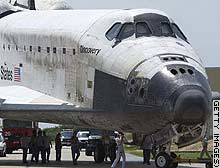
The space shuttle is going to fly again, this time in July.
"There was a strong, concerted opinion from several folks that we should wait until we have a good design on these pieces of foam and then change them before we go flying," Mr. Hale said, "That's not without merit and we considered it very strongly.There must be enough political pressure to keep this thing flying in piste of the significant risks. I can't watch any more. It's going to be the annual heart-attck-watch for the next few years as they keep flying these birds.
"But at the end of the day, it is appropriate to make one change at a time with the biggest problem we have, and then work our way to the next situation."
Reducing falling fuel tank debris has been a priority for NASA since the loss of the shuttle Columbia on Feb. 1, 2003. Foam insulation falling from the tank during the launching damaged Columbia's heat shield, causing the destruction of the craft and the deaths of seven astronauts as the ship attempted to return through the atmosphere from a science mission.
When Discovery flew last July on the first mission since Columbia, a greatly reduced but hazardous amount of foam still fell from its redesigned tank during the launching. Afterward, engineers removed more than 37 pounds of foam that formed two air ramps, or deflectors, that protected pressurized fuel lines and a tray guiding cables down the side of the tank, places from which the biggest pieces of foam fell in the last mission.
Mr. Hale said removing the ramps was "the largest aerodynamic change that we have made since the shuttle first flew" and its effects needed to be well understood before making more modifications.
"We're in a flight test program," he said. "When you make a major change, you should fly that major change and if you have to make additional changes then you make them after the flight."
Mr. Hale said a major factor determining when to launch Discovery is completing wind tunnel tests to confirm computer predictions that it is safe to fly the fuel tank with the large foam ramps removed. A final determination may not be made before the middle of June, he said.

No comments:
Post a Comment